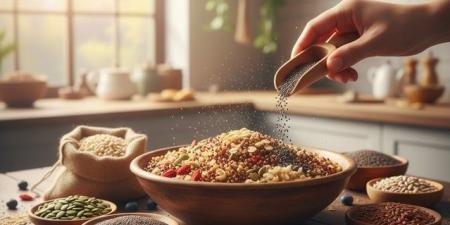نعرض لكم زوارنا أهم وأحدث الأخبار فى المقال الاتي:
5 Ways to Make a Healthier Cup of Tea Without Changing Taste - المصدر 24, اليوم الخميس 13 نوفمبر 2025 10:25 صباحاً
المصدر 24 - Tea is one of the world’s most beloved drinks — comforting, aromatic, and endlessly customizable.
But while tea itself is naturally healthy, the way many people prepare it can reduce those benefits without them even realizing.
The good news? You can make your daily cup healthier, cleaner, and more nutritious without sacrificing flavor. No strange ingredients, no herbal blends you’ve never heard of — just simple, practical adjustments that keep your tea tasting exactly the way you love it.
Here are five easy, science-backed ways to boost the health benefits of your tea without changing its delicious taste.
1. Use Fresh, Filtered Water Instead of Tap Water
Most people think the tea leaves are the most important part of the cup — but the water matters just as much.
Chlorine, minerals, and impurities found in tap water can interfere with tea’s natural flavor and even reduce its antioxidant content.
Why it matters:
Tea contains catechins — powerful antioxidants responsible for many of its health benefits. Certain minerals in tap water can bind to these compounds and reduce their effectiveness.
Science says:
A study from Environmental Science & Technology found that hard water can decrease tea catechins by up to 30%, lowering its health-boosting potential.
How to improve your tea:
Use fresh, filtered water every time.
Avoid reheating old boiled water — it loses oxygen and dulls the flavor.
Pro tip:
If you want brighter flavor and better aroma, boil water only once and use it immediately.
2. Skip the Sugar — Use Natural Enhancers Instead
Sugar is the fastest way to turn a healthy cup of tea into a calorie-heavy drink.
But removing it doesn’t mean your tea has to taste bland.
Why it matters:
Excess sugar is linked to weight gain, inflammation, and higher risk of heart disease — it cancels out the advantages of tea’s antioxidants.
Simple alternatives that keep the flavor the same:
Add a tiny drop of honey (½ teaspoon is enough).
Drop in a thin slice of lemon for brightness.
Add a cinnamon stick for natural sweetness with zero sugar.
None of these overpower the original flavor — they complement it softly.
Pro tip:
If you’re trying to reduce sugar, cut it gradually over a week. Most people don’t notice the difference after day five.
3. Choose High-Quality Tea Leaves Instead of Dust Bags
Most commercial tea bags contain “tea dust,” the lowest grade of tea leaves.
Whole-leaf or loose-leaf teas retain more nutrients, better flavor, and fewer additives.
Why it matters:
Tea dust oxidizes faster, losing antioxidants and gaining bitterness.
Whole leaves brew more slowly and release beneficial compounds more fully.
Science says:
Research in the Journal of Food Science shows that loose-leaf tea contains up to 60% more polyphenols than standard tea bags.
How to upgrade without changing taste:
Buy pyramid-shaped bags (they hold larger leaf fragments).
Choose brands that specify “whole leaf” or “full leaf.”
Store tea in airtight containers away from light and moisture.
Pro tip:
Loose tea isn’t stronger — it’s cleaner. The flavor is the same but smoother and purer.
4. Control the Brewing Time and Temperature
Most people brew tea either too hot or too long, leading to bitterness — and a loss of health benefits.
Why it matters:
Catechins and antioxidants break down at high temperatures.
Over-brewing releases tannins that make the tea harsh.
Ideal brewing guidelines:
Green tea: 70–80°C (not boiling), 2–3 minutes
Black tea: 95–100°C, 3–4 minutes
Herbal tea: boiling water, 5 minutes
These times maintain the tea’s natural flavor while protecting nutrients.
Science says:
Studies from Food Chemistry show that proper brewing can increase antioxidant absorption by up to 40%.
Pro tip:
If the tea tastes bitter, don’t add sugar — just reduce brewing time by 30 seconds next time.
5. Add a Splash of Milk — or Skip It Entirely (Depending on Your Tea)
Milk in tea is a global debate — does it make tea healthier or less healthy?
The truth: it depends on the tea type.
Why it matters:
Milk contains proteins that can bind to antioxidants in some teas, reducing their absorption.
But in black tea, milk doesn’t significantly alter the taste or health profile if used moderately.
Best practice:
For black tea: A small splash of milk is fine.
For green tea: Avoid milk — it interferes with catechin absorption.
For herbal tea: No need for milk; it changes the flavor too much.
Science says:
Research from Nutrition Research found that adding milk reduced antioxidant availability in green tea but had minimal effect on black tea.
Pro tip:
If you enjoy creamy tea, try oat milk — neutral flavor that doesn’t overpower the tea.


















0 تعليق